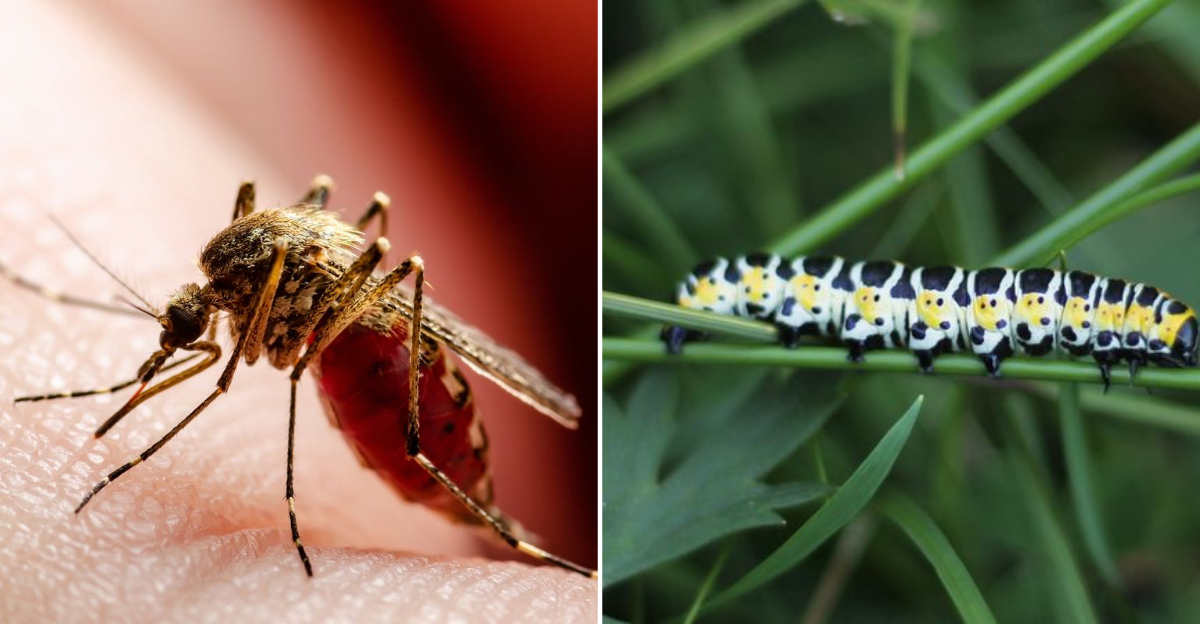California’s forests are beautiful—but they’re also full of tiny threats you’ll never see coming.
I’ve explored redwood groves, pine ridges, and rocky canyons—and I promise, the insects hiding in leaf litter and under logs aren’t always harmless.
From scorpions that glow under a UV light, to assassin bugs that strike like a hornet, these 21 forest dwellers pack serious sting, bite, or toxin power.
Read on (and stay alert!)—your next hike might bring more than just fresh air.
1. Blood-Thirsty Mosquitoes
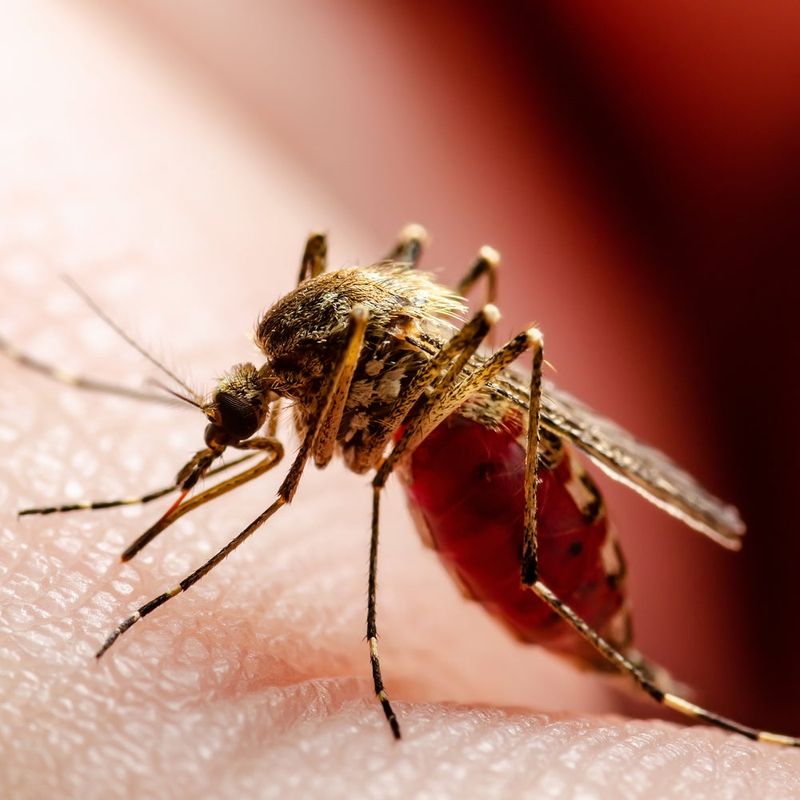
Last summer, I made the rookie mistake of forgetting bug spray during my Sequoia camping trip. Big mistake! The mosquitoes descended like tiny vampires, leaving me itching for days. These flying nuisances do more than just ruin a good hike.
California mosquitoes can transmit West Nile virus, St. Louis encephalitis, and Western equine encephalitis. The females (yes, only the ladies bite) need blood to produce eggs, using a specialized mouth that pierces skin and injects saliva containing anticoagulants.
Dawn and dusk are their favorite hunting times. Wear long sleeves, use DEET repellents, and eliminate standing water around campsites. Those little wading pools of rainwater are basically mosquito nurseries!
2. Venomous Black Widow Spiders
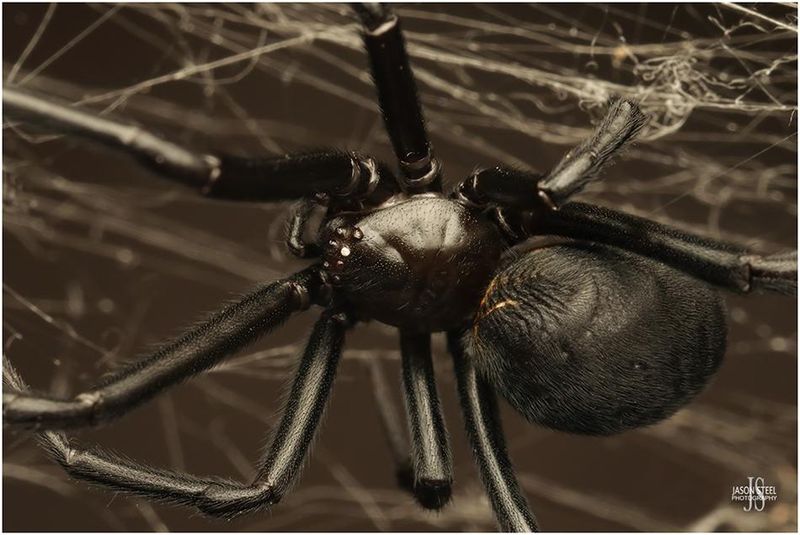
The shiny black body with that distinctive red hourglass marking still gives me chills. I nearly grabbed one while reaching for firewood behind my cabin near Big Sur! Black widows prefer dark, undisturbed areas in California’s forests—woodpiles, tree hollows, and under logs.
Their venom contains neurotoxins that can cause intense pain, muscle cramps, and in rare cases, serious complications. Despite their fearsome reputation, these arachnids aren’t aggressive unless threatened or protecting egg sacs.
Always shake out hiking boots before wearing them and use a flashlight when grabbing wood. The females are the dangerous ones—males and juveniles pose little threat to humans. When camping, I now religiously check my sleeping bag before crawling in.
3. Stinging Bark Scorpions
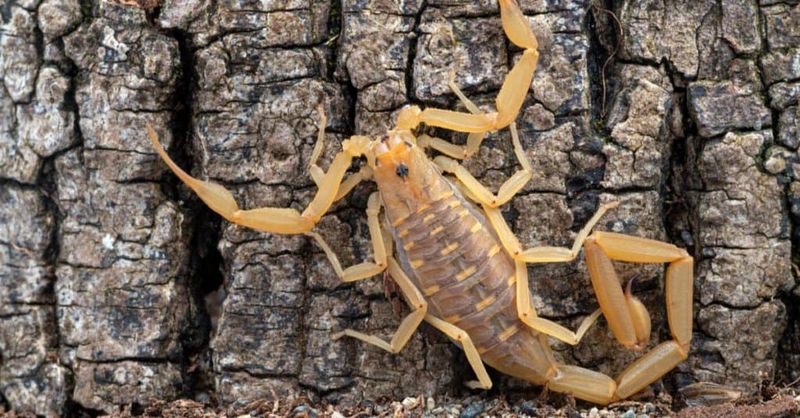
My night hike through Joshua Tree took an unexpected turn when my flashlight revealed a bark scorpion on a tree just inches from my hand! Their pale yellow-brown bodies blend perfectly with forest debris. These nocturnal hunters possess a painful sting that feels like a burning electrical shock, followed by numbness and tingling that can last for days.
While rarely fatal to healthy adults, their venom can cause severe reactions in children and those with allergies. They’re masters at squeezing into tiny cracks and crevices, making them unwelcome tent companions.
Always check your sleeping area and shake out shoes and clothing before use. I now carry a UV flashlight on camping trips—scorpions glow an eerie blue-green under ultraviolet light, making them easier to spot.
4. Aggressive Red Imported Fire Ants

The picnic spot looked perfect until I set down my backpack on what turned out to be a fire ant colony. The synchronized attack that followed taught me a lesson I’ll never forget! These invasive insects have established footholds in Southern California forests, creating mounds that house up to 250,000 workers.
When disturbed, they swarm in coordinated attacks, latching on with powerful jaws before pivoting their bodies to deliver multiple stings. Each sting injects alkaloid venom that creates painful, pus-filled blisters. Watch for dome-shaped mounds about 18 inches high, especially in sunny forest clearings.
If attacked, brush ants off quickly rather than smashing them—crushed ants release pheromones that trigger more aggressive stinging from their nestmates.
5. Lurking Western Forest Scorpions

While setting up camp in Mendocino National Forest, I nearly placed my tent over a family of western forest scorpions! These robust arachnids reach up to 2.5 inches long with dark brown or black bodies and powerful pincers. Unlike their desert cousins, Uroctonus mordax thrives in California’s moist forest environments, hiding under rocks, logs, and leaf litter.
Their sting causes localized pain, swelling, and numbness but rarely requires medical attention unless you’re allergic. What makes them particularly startling is their habit of freezing when spotted, then scurrying away with surprising speed.
Always wear gloves when gathering firewood and check your sleeping area thoroughly. I’ve learned to keep food in sealed containers—these predators are attracted to insects that might be drawn to your midnight snacks.
6. Intimidating Giant Hairy Scorpions

The flashlight beam caught something moving near my backpack—a scorpion the size of my palm! The giant hairy scorpion lives up to its name, reaching a whopping 6 inches in length. As California’s largest scorpion species, these impressive arachnids inhabit the state’s southern forests and woodland edges.
Their bodies are covered in sensitive hair-like structures that detect air movements, making them excellent nighttime hunters. Despite their frightening appearance, their venom is relatively mild, causing pain similar to a bee sting, though the experience is still thoroughly unpleasant.
They’re attracted to dark, cool spaces—exactly where campers tend to store gear. I now hang backpacks and equipment instead of leaving them on the ground. And after finding one in my boot, I’ve become religious about shaking out footwear!
7. Misunderstood Tarantulas

My hiking buddy’s blood-curdling scream still rings in my ears—all because a fuzzy tarantula crossed our path in Angeles National Forest! Despite their fearsome reputation, these gentle giants are among the least dangerous creatures on this list.
California’s native tarantulas are typically docile, preferring to retreat rather than confront humans. Their bite, while painful, contains venom no worse than a bee sting for most people. The real defense mechanism is their urticating hairs—when threatened, they can flick these irritating bristles that cause itching and inflammation if they contact skin or eyes.
Male tarantulas are most commonly encountered in late summer and fall when they wander in search of mates. I’ve learned to simply step aside and let these magnificent arachnids pass—they’re actually beneficial predators that control pest populations.
8. Terrifying Tarantula Hawks

The metallic blue-black wasp hovering over wildflowers looked beautiful until my ranger friend whispered, “Tarantula hawk—has one of the most painful stings in the world!” I immediately stepped back. These massive wasps (actually a type of spider wasp) hunt tarantulas as living incubators for their young.
After paralyzing the spider with their excruciating sting, they lay an egg on it, providing a fresh food source for their hatching larva. Entomologist Justin Schmidt, who created a pain scale for insect stings, describes their sting as “immediate, excruciating, and totally debilitating.”
Fortunately, they’re not aggressive toward humans unless handled or stepped on. When hiking through California’s forests in summer, I give these orange-winged nightmares plenty of space—their vivid colors serve as nature’s warning sign!
9. Sneaky Western Corsair Assassin Bugs

While photographing wildflowers in Yosemite, I felt a sharp pain on my wrist—a western corsair had decided I looked like lunch! These stealthy predators have earned their “assassin” nickname through ambush hunting tactics. Sporting slender bodies about an inch long with distinctive red-orange markings, these bugs inject digestive enzymes that liquefy their prey’s insides.
When they bite humans (usually in self-defense), it feels like a hornet sting and can cause significant swelling. Some people develop allergic reactions to their saliva, making encounters potentially serious. Despite their fearsome reputation, corsairs actually help control pest populations in California’s forests.
I’ve learned to carefully check the undersides of leaves and bark before leaning against trees. Long sleeves provide good protection during hikes, especially in summer when they’re most active.
10. Hostile Texas Paper Wasps

My peaceful lunch under a pine tree turned chaotic when I realized I was sitting near a paper wasp nest! These reddish-brown insects with yellow markings build distinctive umbrella-shaped nests that hang from branches and eaves.
Despite their name, Texas paper wasps (Polistes apachus) have established territories throughout California’s forests. Unlike yellowjackets, they’re not typically attracted to human food, but they will aggressively defend their colonies if they perceive a threat. Their stings deliver a burning pain that can last for hours, and they can sting repeatedly without dying.
I’ve learned to scan overhead before setting up camp. Early spring is when queens start building new nests, making them easier to spot and avoid before colonies grow. If you encounter them, back away slowly—rapid movements trigger their defense instincts.
11. Tree-Damaging Bark Beetles

The devastation became clear as I hiked through Sierra National Forest—hundreds of withered pines, victims of tiny bark beetles no bigger than a grain of rice. My forester friend pointed out the telltale spiral patterns under loose bark.
These destructive insects, including emerald ash borers and goldspotted oak borers, tunnel beneath tree bark, disrupting nutrient flow and eventually causing the trees to die. While they don’t directly harm humans, they’ve transformed California’s forest landscapes, creating hazardous standing trees (called snags) that can collapse without warning during storms or high winds.
Climate change has worsened infestations, as drought-stressed trees can’t produce enough defensive resin. When camping, I now carefully assess surrounding trees for signs of infestation—discolored crowns, exit holes, or peeling bark—and avoid setting up beneath potential widow-makers.
12. Massive California Root Borers

The enormous beetle that crashed into our campfire almost gave my nephew a heart attack! At nearly 3 inches long with massive mandibles, the California root borer looks like something from a sci-fi movie. These impressive insects (Prionus californicus) are among the largest beetles in North America.
Their larvae spend years underground feeding on tree roots, potentially weakening forest giants from below. Adult males fly clumsily on summer evenings searching for mates, often attracted to lights and campfires.
While they look terrifying, they’re actually harmless to humans—those intimidating jaws are for mating displays, not attacking people. Nevertheless, their size and sudden appearances make for startling encounters. I’ve learned to keep flashlights pointed downward during night hikes to avoid attracting these and other nocturnal insects. Their populations have declined in some areas due to habitat loss.
13. Chemical-Wielding Yellow-Spotted Millipedes
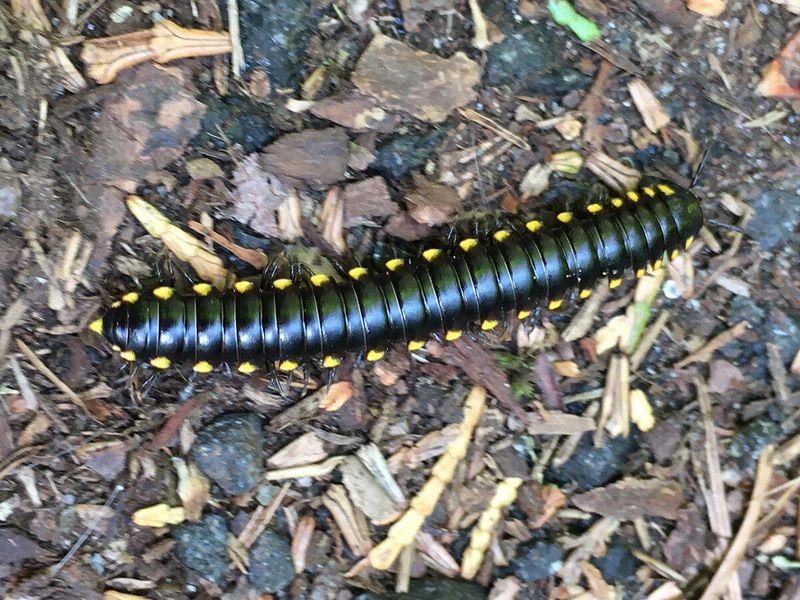
The curled-up black millipede with yellow spots seemed harmless until I noticed the almond smell—cyanide! I quickly washed my hands after my daughter pointed one out during our redwood forest hike. These fascinating forest dwellers, Harpaphe haydeniana, deploy a surprising chemical defense when threatened.
They produce hydrogen cyanide gas with a distinctive bitter almond odor as a warning to predators. While not enough to harm humans through brief contact, the toxin can cause skin irritation and is dangerous if ingested or if the residue gets into eyes.
Yellow-spotted millipedes play important roles in decomposing fallen leaves and enriching forest soils. I’ve taught my kids the “look but don’t touch” rule for these and other colorful forest creatures. Their bright markings serve as nature’s warning sign—a perfect example of aposematic coloration signaling danger.
14. Disease-Spreading Blow Flies
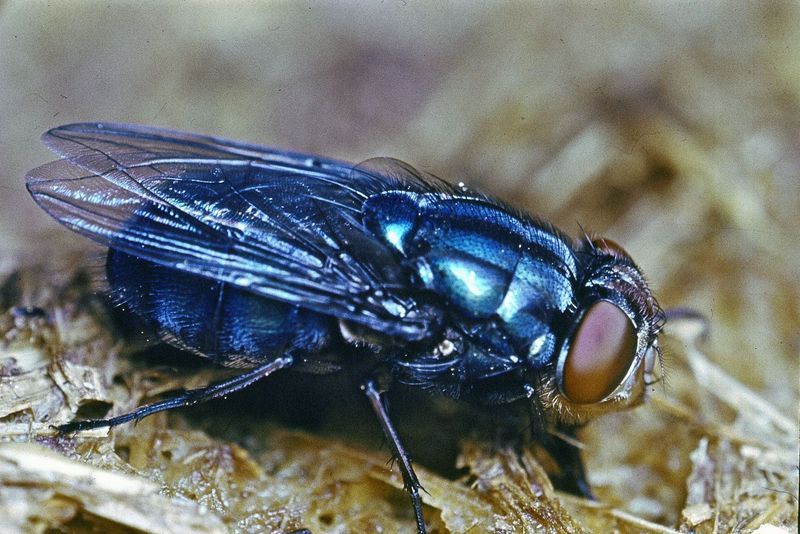
The metallic green and blue flies buzzing around our picnic weren’t just annoying—they were potentially dangerous blow flies! I quickly covered our food when I recognized their distinctive shimmering bodies. These common forest insects are attracted to decaying matter, including animal carcasses, where they lay eggs that hatch into flesh-eating maggots.
Their ecological role as decomposers is valuable, but their habit of landing on both rotting materials and human food makes them efficient disease vectors. They can transmit bacteria causing dysentery, cholera, and food poisoning.
During my California camping trips, I’ve learned to keep food tightly sealed and promptly clean dishes. Hanging mesh food screens over picnic areas helps keep these unwanted guests away. Their presence often indicates a decomposing animal nearby, so if you suddenly notice many blow flies, it might be time to relocate your lunch spot!
15. Acid-Spraying Honey-Pot Ants

My hiking partner’s startled yelp made me jump—a stream of formic acid had just hit his ankle, courtesy of a honey-pot ant! These remarkable insects get their name from specialized worker ants whose abdomens swell with liquid food reserves.
California’s forest-dwelling honey-pot species defend their colonies aggressively, spraying formic acid that causes burning sensations and skin irritation. While not typically dangerous, repeated exposure can trigger allergic reactions in sensitive individuals. Their colonies often establish along forest trails, creating potential ambush points for bare-legged hikers.
I’ve learned to watch for their distinctive mounds with multiple small entrances. When we spot them, we give them wide berth—these industrious creatures play important roles in seed dispersal and soil aeration. Their remarkable storage abilities help colonies survive California’s dry seasons when food becomes scarce.
16. Painful Harvester Ants
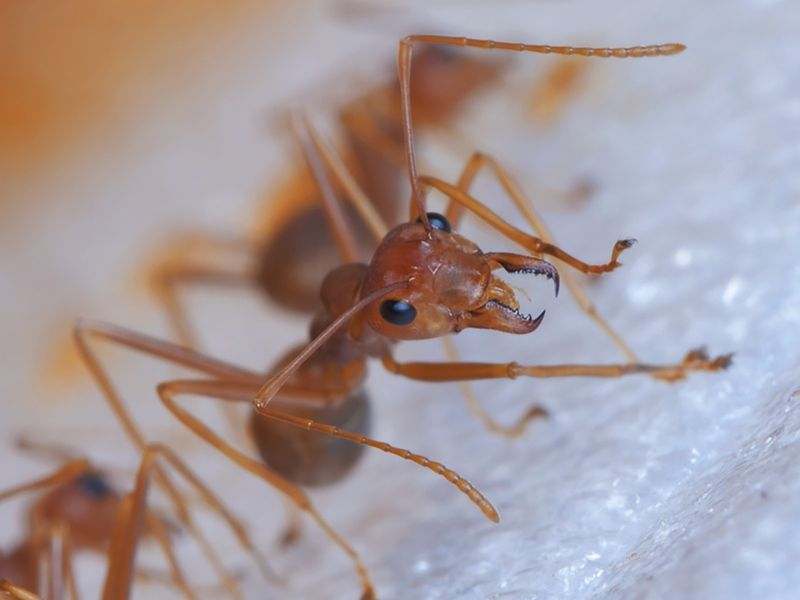
The burning sensation shot through my foot like lightning—I’d accidentally stepped on a harvester ant colony while exploring Griffith Park in my sandals. Lesson painfully learned! These large, reddish-brown ants construct distinctive crater-shaped nests with cleared circles around the entrances.
Unlike many ants that bite and then spray acid, harvesters deliver venom through a true sting. Their venom contains compounds that trigger intense pain, sometimes lasting for hours, and is considered among the most potent of any insect relative to their size.
California’s forests host several harvester species that collect and store seeds in underground granaries. While their ecological role is beneficial, their defensive nature makes them formidable forest residents. I now scan the ground carefully when hiking and always wear closed shoes, especially in dry, open areas of forests where they prefer to nest.
17. Irritating Painted Lady Caterpillars
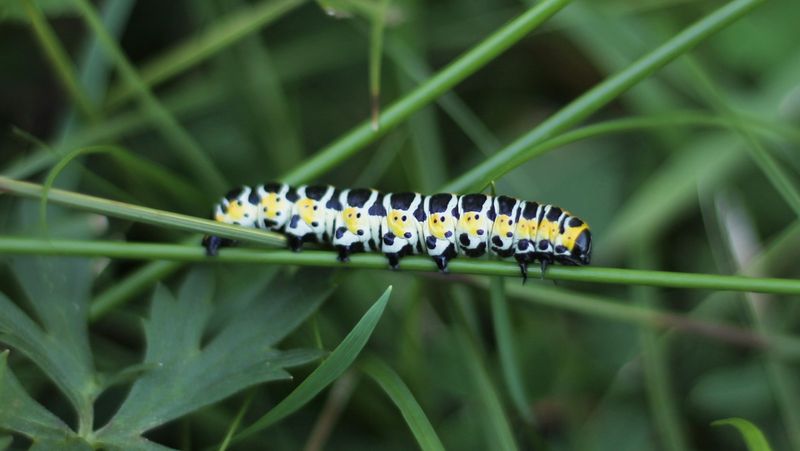
The spiny black caterpillar with orange markings looked beautiful on that thistle plant—until my son touched it and immediately developed an itchy rash! Painted lady caterpillars may transform into gorgeous butterflies, but their larvae pack a surprising punch. These bristly creatures are covered in urticating (irritating) hairs that can break off in human skin, causing reactions ranging from mild irritation to painful welts in sensitive individuals.
Found throughout California’s forests and meadows, they feed voraciously on thistles, mallows, and other plants before their metamorphosis. Despite their defensive capabilities, painted lady caterpillars are important pollinators-in-training.
I’ve taught my kids to admire these future butterflies from a safe distance. If contact occurs, immediately wash the area with soap and water, and apply ice to reduce swelling—a small first aid kit is now a permanent fixture in my hiking pack.
18. Destructive Spongy Moth Larvae

The oak trees along my favorite Sierra Nevada trail were nearly leafless—stripped bare by hordes of hungry spongy moth caterpillars. Their fuzzy bodies covered trunks and branches like a living carpet! Formerly known as gypsy moths, these invasive pests defoliate vast areas of California forests during outbreak years. While the caterpillars don’t bite or sting, their tiny hairs contain a skin irritant that causes an itchy rash in many people.
Airborne hairs can also trigger respiratory problems and eye irritation when populations explode. Beyond human health concerns, these voracious eaters threaten forest ecosystems by weakening trees, making them vulnerable to disease and other pests.
During hikes, I now wear long sleeves during spring and early summer when larvae are active. If you encounter infested areas, it’s wise to change and wash clothes promptly after your outdoor adventure.
19. Structural-Damaging Wood-Boring Beetles
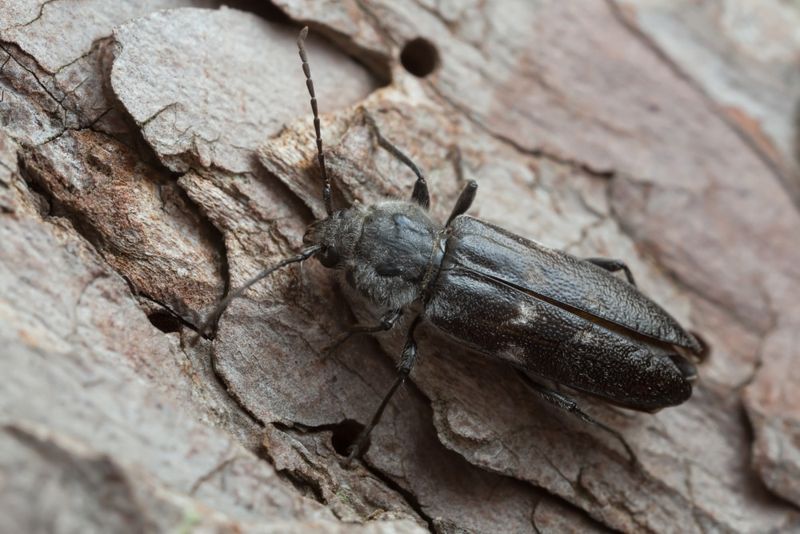
The ranger pointed to tiny holes in the forest cabin’s support beams—evidence of wood-boring beetles slowly turning the structure into sawdust from within! These silent destroyers are among the forest’s most economically damaging insects.
Various species, including powderpost beetles and old house borers, lay eggs in wood crevices. Their larvae then tunnel through the material, potentially for years, before emerging as adults through distinctive exit holes. While they don’t directly harm humans, their structural damage can create dangerous conditions in forest buildings, bridges, and even living trees.
During my volunteer work with forest conservation groups, I’ve learned to identify the frass (sawdust-like waste) that indicates an active infestation. For campers using forest cabins, inspect wooden furniture before sitting—I once got a painful splinter from a beetle-weakened chair that collapsed under normal weight!
20. Tree-Destroying Invasive Shot-Hole Borers
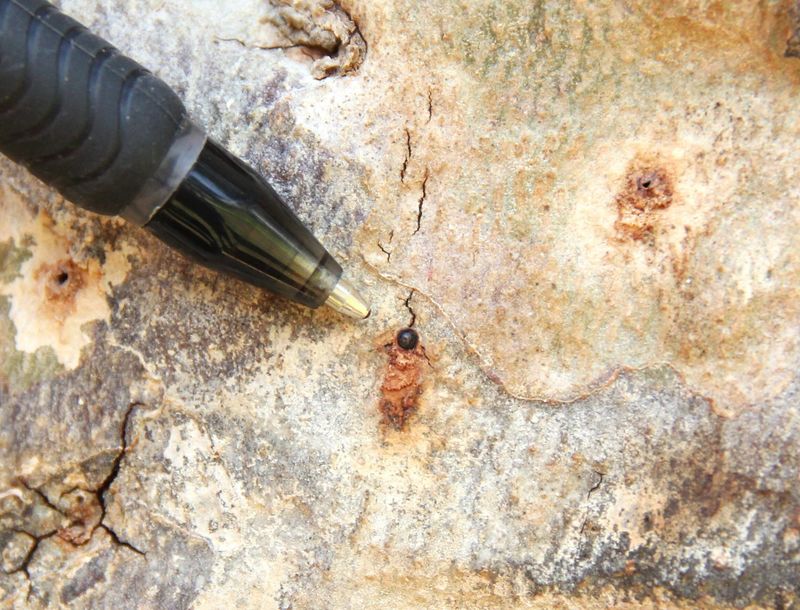
The dying sycamore trees along my favorite riverside trail in Angeles National Forest left me heartbroken. The culprit? Tiny invasive shot-hole borers barely visible to the naked eye. These destructive beetles, originally from Southeast Asia, tunnel into tree trunks, introducing a fungus that serves as food for their larvae but blocks water and nutrient transport in the tree.
The telltale signs include perfectly round entry holes resembling shotgun damage, oozing sap, and branch dieback. Unlike native borers that typically attack weakened trees, these invaders target healthy specimens. While they pose no direct threat to humans, their ecological impact is devastating.
They’ve devastated thousands of California’s native trees, transforming once-shaded riparian areas into sun-baked clearings. As an amateur naturalist, I now report suspicious tree symptoms to forest services—early detection is crucial for controlling their spread.
21. Venom-Packing Asian Giant Hornets

My heart nearly stopped when I spotted what looked like a flying thumb with wings during a Northern California camping trip. The ranger later confirmed my fears—Asian giant hornets had been sighted in the region.
These massive insects, sometimes called “murder hornets,” can grow over two inches long with a wingspan of three inches. Their stingers deliver a potent neurotoxic venom that feels like “hot metal driving into your skin,” according to victims. Multiple stings can require hospitalization, and approximately 50 people die annually in Japan from their attacks.
Although still rare in California, occasional sightings have triggered monitoring programs. If you spot one, maintain distance—they can spray venom into eyes from several feet away! I now carry an insect identification guide and report unusual sightings to park authorities. Their potential impact on native bee populations concerns ecologists.
